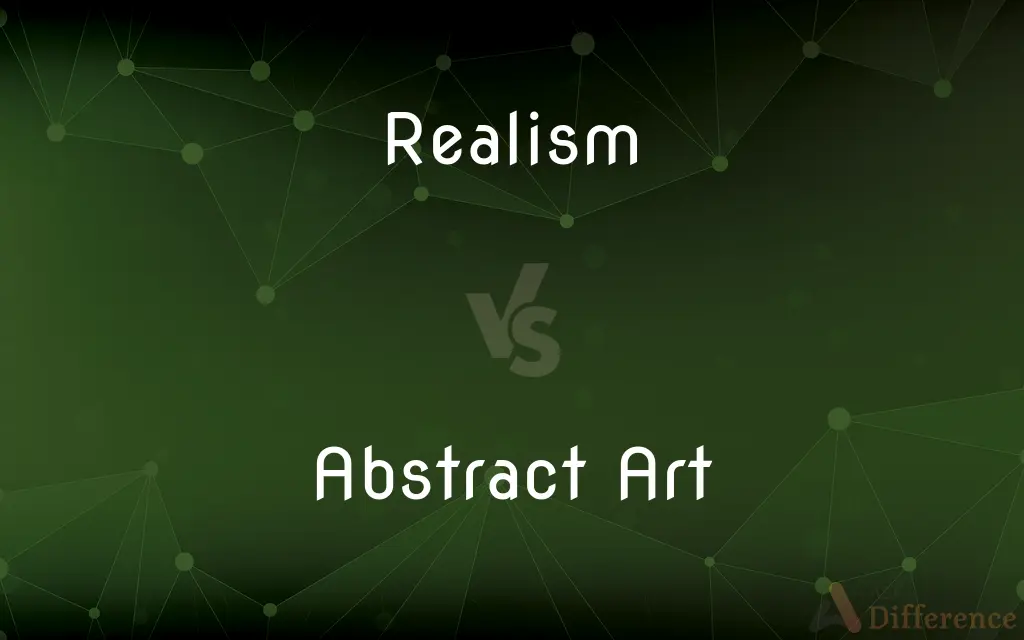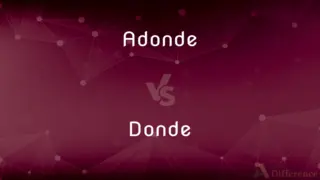Realism vs. Abstract Art — What's the Difference?
Edited by Tayyaba Rehman — By Fiza Rafique — Published on November 4, 2023
Realism depicts objects and scenes as they appear, while Abstract Art uses shapes, colors, and forms to represent concepts. Both reflect the artist's perspective.

Difference Between Realism and Abstract Art
Table of Contents
ADVERTISEMENT
Key Differences
Realism, as an art form, aims to portray subjects as they truly are, capturing the fine details, colors, and shadows of its muse. Abstract Art, in contrast, doesn’t seek to represent reality. Instead, it leverages colors, shapes, and patterns to convey emotions, ideas, or concepts. Both Realism and Abstract Art have distinct histories and philosophies that shaped their evolution.
Realism emerged in the mid-19th century, particularly in response to the Romanticism movement. Artists practicing Realism aimed to depict the everyday and common life of people, portraying the good, the bad, and the mundane. Abstract Art, however, emerged later, around the early 20th century, representing a break from traditional representation of objects. While Realism captures life as it is, Abstract Art captures life as it feels.
In Realism, accuracy and attention to detail are paramount. The aim is to make viewers believe they're looking at the real thing. Conversely, Abstract Art invites interpretation, urging viewers to dive deep into their imagination and emotions. With Realism, you might admire a beautifully painted portrait or landscape. In Abstract Art, you might contemplate a swirl of colors or an unusual combination of shapes.
Techniques vary widely between Realism and Abstract Art. Realistic artists might use techniques like chiaroscuro (the play of light and shadow) to render their subjects vividly. Abstract artists, meanwhile, might play with formlessness, unpredictability, and the juxtaposition of elements. While Realism seeks clarity and precision, Abstract Art thrives on ambiguity.
Comparison Chart
Representation
Depicts objects as they appear
Uses shapes and colors to represent ideas or feelings
ADVERTISEMENT
Historical Origins
Mid-19th century in response to Romanticism
Early 20th century as a break from tradition
Technique Focus
Accuracy and detail
Emotion and unpredictability
Interpretation
Meant to be seen as is
Invites viewer interpretation
Subject Matter
Everyday life, landscapes, portraits
Emotions, concepts, experiences
Compare with Definitions
Realism
Art that portrays subjects truthfully.
The painting's realism made it look like a photograph.
Abstract Art
Emphasis on elements over real objects.
Through abstract art, she communicated her innermost feelings.
Realism
A mid-19th century movement focusing on everyday life.
The novel was praised for its realism in character development.
Abstract Art
Visual language of shape, form, and color.
Abstract art uses a visual language unique to each viewer.
Realism
A counter-response to Romanticism.
Artists turned to realism to depict the world as it truly was.
Abstract Art
Art that uses colors and shapes for expression.
The gallery displayed vibrant pieces of abstract art.
Realism
An inclination toward literal truth and pragmatism.
Abstract Art
A break from traditional representation.
Abstract art allowed him to express emotions beyond physical forms.
Realism
Representation based on precise observation.
His dedication to realism was evident in his meticulous brush strokes.
Abstract Art
Art that invites interpretation.
Her favorite piece of abstract art resembled the chaos of the cosmos.
Realism
The representation in art or literature of objects, actions, or social conditions as they actually are, without idealization or presentation in abstract form.
Realism
The scholastic doctrine, opposed to nominalism, that universals exist independently of their being thought.
Realism
The modern philosophical doctrine, opposed to idealism, that objects exist independently of their being perceived.
Realism
A concern for fact or reality and rejection of the impractical and visionary.
Realism
An artistic representation of reality as it is.
Realism
(sciences) The viewpoint that an external reality exists independent of observation.
Realism
(philosophy) A doctrine that universals are real—they exist and are distinct from the particulars that instantiate them.
Realism
As opposed to nominalism, the doctrine that genera and species are real things or entities, existing independently of our conceptions. According to realism the Universal exists ante rem (Plato), or in re (Aristotle).
Realism
Fidelity to nature or to real life; representation without idealization, and making no appeal to the imagination; adherence to the actual fact.
Realism
The practise of assessing facts and the probabilities of the consequences of actions in an objective manner; avoidance of unrealistic or impractical beliefs or efforts. Contrasted to idealism, self-deception, overoptimism, overimaginativeness, or visionariness.
Realism
The attribute of accepting the facts of life and favoring practicality and literal truth
Realism
(philosophy) the philosophical doctrine that physical object continue to exist when not perceived
Realism
The state of being actual or real;
The reality of his situation slowly dawned on him
Realism
An artistic movement in 19th century France; artists and writers strove for detailed realistic and factual description
Realism
(philosophy) the philosophical doctrine that abstract concepts exist independent of their names
Realism
Art emphasizing accuracy and detail.
Realism in her portrait work was unmatched.
Common Curiosities
What is the main goal of Realism in art?
Realism seeks to depict subjects as they truly appear in real life.
How does Abstract Art differ from traditional art forms?
Abstract Art breaks from representing real objects, focusing instead on feelings and ideas through shapes and colors.
When did Realism become popular?
Realism gained popularity in the mid-19th century as a response to Romanticism.
Is Realism always about people and landscapes?
No, while often focused on everyday life and scenes, Realism can encompass various subjects.
Which movement came first, Realism or Abstract Art?
Realism preceded Abstract Art, emerging in the mid-19th century.
Can a Realistic painting evoke emotions like Abstract Art?
Absolutely, emotions can be evoked by any form of art, depending on the viewer's connection.
Can Abstract Art be of any subject?
Yes, Abstract Art can represent a variety of subjects, but through unconventional forms and symbols.
What tools do artists use for Realism?
While varied, common tools include fine brushes, pencils, and charcoal to achieve detailed effects.
Why did Abstract Art emerge?
Abstract Art emerged as artists sought new ways to express feelings and ideas beyond traditional representation.
Can Realism be seen in modern digital art?
Yes, many digital artists use technology to create highly realistic depictions in their work.
Why do some find Abstract Art hard to understand?
Abstract Art is open to interpretation and often relies on personal emotions and experiences, making it subjective.
How do techniques differ between Realism and Abstract Art?
Realism emphasizes accuracy and detail, while Abstract Art plays with unpredictability and emotion.
Can an artwork be both Realistic and Abstract?
While distinct, elements of both can sometimes be combined in a single piece.
Are there sub-genres within Abstract Art?
Yes, including Cubism, Abstract Expressionism, and Suprematism, among others.
Do all cultures have forms of Abstract Art?
While interpretations vary, many cultures have art forms that prioritize symbolic representation over realism.
Share Your Discovery

Previous Comparison
Business Market vs. Consumer Market
Next Comparison
Adonde vs. DondeAuthor Spotlight
Written by
Fiza RafiqueFiza Rafique is a skilled content writer at AskDifference.com, where she meticulously refines and enhances written pieces. Drawing from her vast editorial expertise, Fiza ensures clarity, accuracy, and precision in every article. Passionate about language, she continually seeks to elevate the quality of content for readers worldwide.
Edited by
Tayyaba RehmanTayyaba Rehman is a distinguished writer, currently serving as a primary contributor to askdifference.com. As a researcher in semantics and etymology, Tayyaba's passion for the complexity of languages and their distinctions has found a perfect home on the platform. Tayyaba delves into the intricacies of language, distinguishing between commonly confused words and phrases, thereby providing clarity for readers worldwide.












































